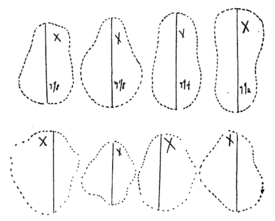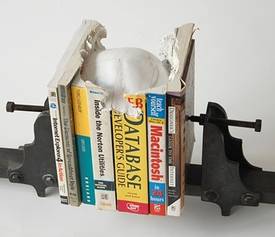[Bruce Schneier's incredibly articulate conclusion to his debate with Kip Hawley. I agree with every damn word. -egg]
Harms of Post-9/11 Airline Security:
As I
posted previously, I have been debating former TSA Administrator Kip Hawley on the
Economist website. I didn't bother reposting my opening statement and rebuttal, because -- even though I thought I did a really good job with them -- they were largely things I've said before. In my closing statement, I talked about specific harms post-9/11 airport security has caused. This is mostly new, so here it is, British spelling and punctuation and all.
In my previous two statements, I made two basic arguments about post-9/11 airport security. One, we are not doing the right things: the focus on airports at the expense of the broader threat is not making us safer. And two, the things we are doing are wrong: the specific security measures put in place since 9/11 do not work. Kip Hawley doesn’t argue with the specifics of my criticisms, but instead provides anecdotes and asks us to trust that airport security—and the Transportation Security Administration (TSA) in particular—knows what it’s doing.
He wants us to trust that a 400-ml bottle of liquid is dangerous, but transferring it to four 100-ml bottles magically makes it safe. He wants us to trust that the butter knives given to first-class passengers are nevertheless too dangerous to be taken through a security checkpoint. He wants us to trust the no-fly list:
21,000 people so dangerous they’re not allowed to fly, yet so innocent they can’t be arrested. He wants us to trust that the deployment of expensive full-body scanners has nothing to do with the fact that the former secretary of homeland security, Michael Chertoff,
lobbies for one of the companies that makes them. He wants us to trust that there’s a reason to confiscate a
cupcake (Las Vegas), a 3-inch plastic
toy gun (London Gatwick), a
purse with an embroidered gun on it (Norfolk, VA), a T-shirt with a
picture of a gun on it (London Heathrow) and a
plastic lightsaber that’s really a flashlight with a long cone on top (Dallas/Fort Worth).
At this point, we don’t trust America’s TSA, Britain’s Department for Transport, or airport security in general. We don’t believe they’re acting in the best interests of passengers. We suspect their actions are the result of politicians and government appointees making decisions based on their concerns about the security of their own careers if they don’t act tough on terror, and capitulating to public
demands that “something must be done”.
In this final statement, I promised to discuss the broader societal harms of post-9/11 airport security. This loss of trust—in both airport security and counterterrorism policies in general—is the first harm.
Trust is fundamental to society. There is an enormous amount written about this; high-trust societies are simply happier and more prosperous than low-trust societies. Trust is essential for both free markets and democracy. This is why open-government laws are so important; trust requires government transparency. The secret policies implemented by airport security harm society because of their very secrecy.
The humiliation, the dehumanisation and the privacy violations are also harms. That Mr Hawley dismisses these as mere “costs in convenience” demonstrates how out-of-touch the TSA is from the people it claims to be protecting. Additionally, there’s actual physical harm: the
radiation from full-body scanners still not publicly tested for safety; and the mental harm suffered by
both abuse survivors and children: the things screeners tell them as they touch their bodies are
uncomfortably similar to what child molesters say.
In 2004, the average extra waiting time due to TSA procedures was
19.5 minutes per person. That’s a total economic loss—in –America—of $10 billion per year, more than the TSA’s entire budget. The increased automobile deaths due to people deciding to drive instead of fly is
500 per year. Both of these numbers are for America only, and by themselves demonstrate that post-9/11 airport security has done more harm than good.
The current TSA measures create an even greater harm: loss of liberty. Airports are effectively rights-free zones. Security officers have enormous power over you as a passenger. You have limited rights to refuse a search. Your possessions can be confiscated. You cannot make jokes, or wear clothing, that airport security does not approve of. You cannot travel anonymously. (Remember when we would mock Soviet-style “show me your papers” societies? That we’ve become inured to the very practice is a harm.) And if you’re on a certain secret list, you cannot fly, and you enter a
Kafkaesque world where you cannot face your accuser, protest your innocence, clear your name, or even get confirmation from the government that someone, somewhere, has judged you guilty. These police powers would be illegal anywhere but in an airport, and we are all harmed—individually and collectively—by their existence.
In his first statement, Mr Hawley related a
quote predicting “blood running in the aisles” if small scissors and tools were allowed on planes. That was said by Corey Caldwell, an Association of Flight Attendants spokesman, in 2005. It was not the statement of someone who is thinking rationally about airport security; it was the voice of irrational fear.
Increased fear is the final harm, and its effects are both emotional and physical. By sowing mistrust, by stripping us of our privacy—and in many cases our dignity—by taking away our rights, by subjecting us to arbitrary and irrational rules, and by constantly reminding us that this is the only thing between us and death by the hands of terrorists, the TSA and its ilk are sowing fear. And by doing so, they are playing directly into the terrorists’ hands.
The goal of terrorism is not to crash planes, or even to kill people; the goal of terrorism is to cause terror. Liquid bombs, PETN, planes as missiles: these are all tactics designed to cause terror by killing innocents. But terrorists can only do so much. They cannot take away our freedoms. They cannot reduce our liberties. They cannot, by themselves, cause that much terror. It’s our reaction to terrorism that determines whether or not their actions are ultimately successful. That we allow governments to do these things to us—to effectively do the terrorists’ job for them—is the greatest harm of all.
Return airport security checkpoints to pre-9/11 levels. Get rid of everything that isn’t needed to protect against random amateur terrorists and won’t work against professional al-Qaeda plots. Take the savings thus earned and invest them in
investigation, intelligence, and emergency response: security outside the airport, security that does not require us to play guessing games about plots. Recognise that 100% safety is impossible, and also that terrorism is
not an “existential threat” to our way of life. Respond to terrorism not with fear but with indomitability.
Refuse to be terrorized.





 While the conformateur is on the head, after the fingers are pressed in so that they are conforming to the head shape, a piece of paper is placed into a frame on the top of the machine. Little pins stick out of the top of the machine, each one attached to one of the fingers, so that the pins now reflect the head shape as well, but in miniature. The frame swings down on a hinge to press the paper into the pins, perforating the paper. In this photo, you can see that the inside of the frame is lined in cork, and there are little holes in the cork where the pins have pressed.
While the conformateur is on the head, after the fingers are pressed in so that they are conforming to the head shape, a piece of paper is placed into a frame on the top of the machine. Little pins stick out of the top of the machine, each one attached to one of the fingers, so that the pins now reflect the head shape as well, but in miniature. The frame swings down on a hinge to press the paper into the pins, perforating the paper. In this photo, you can see that the inside of the frame is lined in cork, and there are little holes in the cork where the pins have pressed.




 Maskull Lasserre, a Canadian sculptor, made this beautiful, realistic skull ("Incarnate") by clamping a collection of obsolete computer manuals together and carving away at the pages.
Maskull Lasserre, a Canadian sculptor, made this beautiful, realistic skull ("Incarnate") by clamping a collection of obsolete computer manuals together and carving away at the pages. 